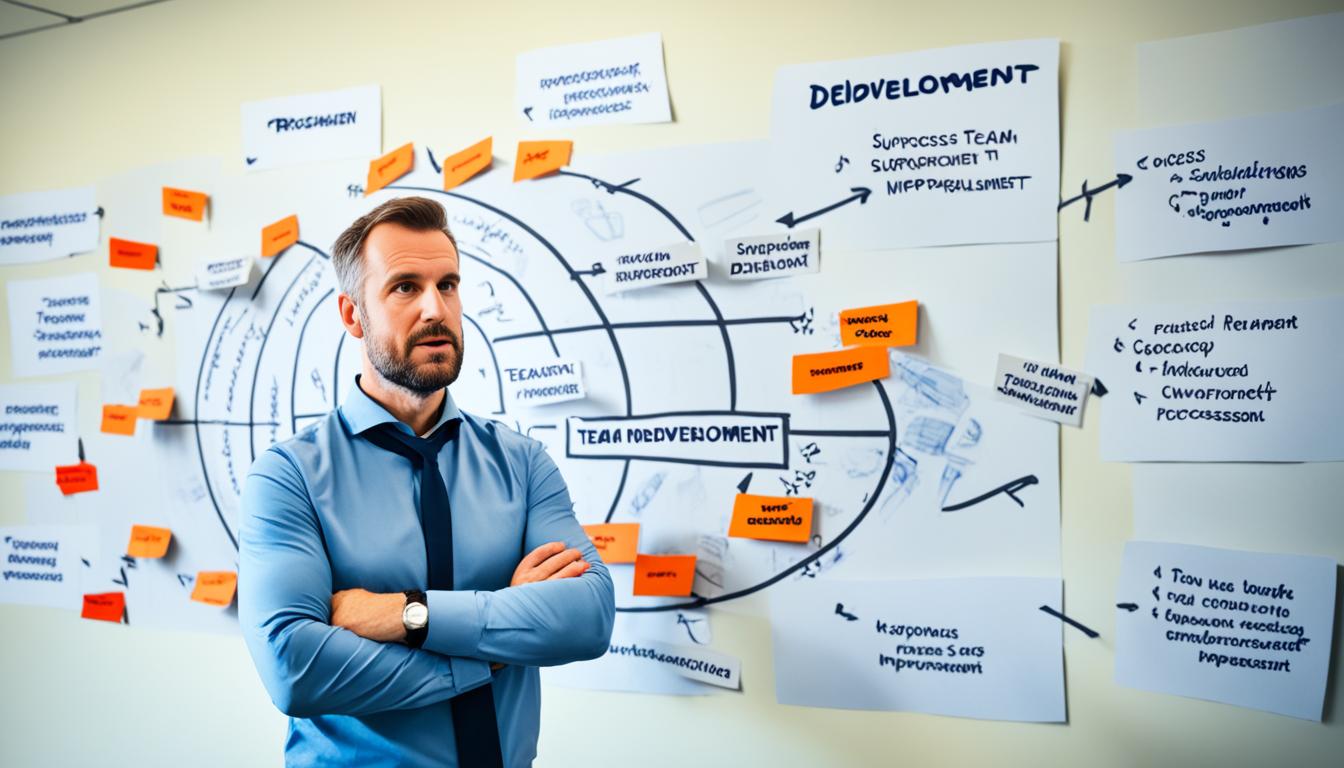Embrace Success: Supervisor Goals Examples for Growth

Do you believe that setting clear goals is the key to unlocking your full potential as a supervisor? Are you aware of the impact that professional development goals can have on your leadership abilities?
Setting meaningful and achievable goals is not just a mere formality but a powerful tool for personal and career growth. It paves the way for self-improvement, enhances your skills, and propels you towards success. Whether you’re aiming to become a more effective leader, enhance specific job-related skills, or foster personal growth, goal setting is the key that unlocks your potential.
Key Takeaways:
- Setting clear goals is crucial for personal and career development.
- Supervisor goals can be categorized into skills development, leadership development, and personal development.
- Employee development goals drive performance management and contribute to organizational success.
- SMART leadership goals provide a framework for effective goal setting.
- Professional goals provide clarity, motivation, and drive towards career advancement.
Types of Development Goals
In order to achieve personal and career growth, it is important to set clear development goals. These goals can be categorized into three main types: skills development goals, leadership development goals, and personal development goals. By focusing on these different areas, you can enhance your job-specific skills, develop your leadership abilities, and foster your personal growth.
Skills Development Goals
Skills development goals are centered around acquiring and honing job-related competencies. By focusing on improving your skills, you can enhance your performance and effectiveness in the workplace. Some examples of skills development goals include:
- Improving technical proficiency
- Enhancing communication skills
- Mastering project management
- Developing problem-solving skills
Leadership Development Goals
Leadership development goals aim to nurture effective leadership skills. By focusing on these goals, you can enhance your ability to lead and inspire others. Some examples of leadership development goals include:
- Mentorship
- Strategic thinking
- Conflict resolution
- Team building
- Change management
Personal Development Goals
Personal development goals focus on holistic growth and well-being. By setting personal development goals, you can enhance various aspects of your life. Some examples of personal development goals include:
- Boosting self-confidence
- Managing stress
- Building professional networks
- Lifelong learning
- Health and wellness

| Development Goals | Description |
|---|---|
| Skills Development Goals | Goals focused on acquiring and honing job-related competencies. |
| Leadership Development Goals | Goals aimed at nurturing effective leadership skills. |
| Personal Development Goals | Goals focused on holistic growth and well-being. |
Importance of Employee Development Goals
Employee development goals play a vital role in driving performance management within organizations. By setting and prioritizing these goals, companies can enhance job performance, foster continuous improvement, attract and retain top talent, as well as foster innovation and adaptability among their workforce.
Employee development goals provide clarity and direction for individuals, allowing them to align their aspirations with organizational objectives. With clearly defined goals, employees can focus their efforts on skill development, acquiring new knowledge, and improving their capabilities, all of which contribute to improved job performance.
Moreover, employee development goals enable effective evaluations, allowing supervisors and managers to assess employees’ progress and provide targeted feedback and support. This feedback loop is essential for identifying strengths and areas for improvement, ultimately driving performance management.
Prioritizing employee development goals cultivates a culture of continuous improvement within organizations. When employees are encouraged to pursue growth and development, they are more likely to experience job satisfaction and increased productivity. This commitment to continuous improvement also helps reduce turnover rates, as employees feel valued and engaged in their work.
Organizations that emphasize employee development goals also have a competitive advantage in attracting and retaining top talent. Top performers are motivated by opportunities for growth and development, and prioritize employers that provide such opportunities. By demonstrating a commitment to employee development, companies can position themselves as desirable employers and attract top talent.
Furthermore, employee development goals foster innovation and adaptability within the workforce. As employees acquire new skills and knowledge, they become equipped to tackle new challenges and take on innovative approaches to problem-solving. This adaptability is crucial in today’s rapidly changing business landscape.

SMART Leadership Goals and Examples
Effective goal setting is essential for leadership development. SMART goals, which are specific, measurable, achievable, relevant, and time-bound, provide a framework for setting objectives that drive growth and success.
Here are some examples of SMART leadership goals:
- Host regular one-on-one meetings: Schedule and conduct regular individual meetings with team members to provide guidance, support, and opportunities for feedback.
- Ask for feedback regularly: Seek input from team members, colleagues, and superiors to gain insights and identify areas for improvement.
- Improve meeting and presentation skills: Enhance communication and leadership abilities by developing effective meeting facilitation and presentation delivery techniques.
- Increase employee engagement: Implement strategies to boost employee motivation, satisfaction, and commitment to their work and the organization.
- Promote continuous learning: Encourage and support ongoing professional development and knowledge acquisition within the team.
- Enhance time management skills: Improve efficiency and productivity by effectively prioritizing tasks, setting realistic deadlines, and minimizing distractions.
- Become more adaptable to change: Develop resilience and the ability to navigate and lead through transitions and uncertainty.
- Become more comfortable with delegation: Delegate tasks and responsibilities to team members based on their skills and abilities while fostering an environment of trust and empowerment.
- Improve resource allocation: Optimize the allocation and utilization of organizational resources to maximize productivity and outcomes.
- Reflect on lessons and learnings: Regularly evaluate and analyze experiences, successes, and failures to derive valuable insights for personal and professional growth.
By setting SMART leadership goals, you can actively work towards enhancing your leadership abilities, driving positive change, and achieving greater success in your role.
Remember, effective goal setting is a continuous process that requires regular evaluation, adjustment, and commitment. Use the SMART framework to ensure your goals are specific, measurable, achievable, relevant, and time-bound, providing a clear roadmap for your leadership development journey.

The Significance of Professional Goals
Professional goals play a crucial role in your career development, providing clarity and direction in your professional journey. When you set clear goals for yourself, you are better able to stay focused and motivated, driving you towards success.
Having defined professional goals allows you to measure your progress and make necessary adjustments along the way. By regularly evaluating your achievements, you can ensure that you are on the right track and stay motivated to continue pushing forward.
One of the key benefits of setting professional goals is the opportunity for skill development and growth. When you establish specific goals related to acquiring new skills or improving existing ones, you create a pathway to enhance your expertise and excel in your field.
Moreover, professional goals aligned with your personal values provide a sense of motivation and purpose. When your goals resonate with what truly matters to you, you are more likely to be driven and committed to achieving them, resulting in a greater sense of fulfillment in your career.
To fully leverage the power of professional goals, it is important to ensure they are measurable. By setting clear objectives and milestones, you can track your progress and celebrate each milestone reached, fueling your motivation and drive.
Ultimately, professional goals give you a roadmap for success, guiding you towards your desired career outcomes. They provide a sense of direction and enable you to take control of your career, making intentional choices that align with your aspirations and values.
So, take the time to reflect on your professional goals, both short-term and long-term. Consider what you want to accomplish, the skills you want to develop, and the growth you want to achieve. With a clear vision and well-defined goals, you can embark on a journey of continuous improvement and growth.

Benefits of Setting Professional Goals:
- Clarity and direction in your career
- Motivation and drive to succeed
- Measurable progress and milestones
- Skill development and growth
- A sense of fulfillment and purpose
By setting professional goals and pursuing them with determination, you can unlock your full potential and create a path towards a successful and fulfilling career.
| Goal | Benefits |
|---|---|
| Acquiring new technical skills | Enhanced job performance and increased marketability |
| Developing leadership abilities | Expanded opportunities for growth and advancement |
| Pursuing personal development | Improved work-life balance and overall well-being |
Conclusion
Setting professional goals is the key to achieving sustained growth and advancing in your career. By defining clear objectives, you gain clarity and direction, which are essential for success. Your goals provide the motivation and drive needed to overcome challenges and stay focused on your professional development.
By aligning your goals with your personal values and using the SMART framework, you can efficiently navigate your professional journey. This framework ensures that your goals are Specific, Measurable, Achievable, Relevant, and Time-bound, making them more actionable and attainable.
Embracing professional goals not only helps you measure your progress but also allows you to continuously learn, adapt, and grow. Through this process, you can achieve the career outcomes you desire while experiencing personal fulfillment along the way.
Remember, setting professional goals is just the beginning. It’s essential to regularly review and adjust these goals as you progress in your career. By doing so, you can remain on the path to sustained growth, continuous improvement, and ultimately, reach your full potential.






